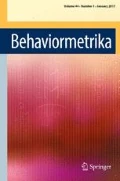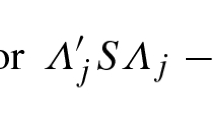Abstract
The asymptotic correlations among maximum likelihood (ML) and various least squares (LS) estimators in factor analysis are derived. The LS estimators include the unweighted (ULS) and weighted estimators for unstandardized variables and the ULS estimators for standardized variables. The derived formulas cover the cases with restrictions on parameters. Numerical examples with simulations are provided to confirm the accuracy of the formulas and the influence of scales on the asymptotic correlations.
Similar content being viewed by others
References
Anderson, T. W. (1987). Multivariate linear relations. In T. Pukkila & S. Puntanen (Eds.), Proceedings of the Second International Tampere Conference in Statistics (pp. 9–36). Tampere, Finland: Department of Mathematical Sciences, University of Tampere.
Anderson, T. W. (1989). Linear latent variable models and covariance structures. Journal of Econometrics, 41, 91–119.
Anderson, T. W. & Amemiya, Y. (1988). The asymptotic normal distribution of estimators in factor analysis under general conditions. The Annals of Statistics, 16, 759–771.
Anderson, T. W. & Rubin, H. (1956). Statistical inference in factor analysis. In J. Neyman, (Ed.) Proceedings of the Third Berkeley Symposium on Mathematical Statistics and Probability, Vol. V (pp. 111–150). Berkeley: University of California Press.
Arbucle, J. L. & Wothke, W. (1999). Amos 4-0 user’s guide. Chicago: SPSS Inc.
Bentler, P. M. (1989). EQS: A structural equations program. Los Angeles: BMDP Statistical Software.
Browne, M. W. (1974). Generalized least squares estimators in the analysis of covariance structures. South African Statistical Journal, 8, 1–24. Reprinted in D. J. Aigner & A. S. Goldberger (Eds.), Latent variables in socioeconomic models (pp. 205-226). Amsterdam: North Holland, 1977.
Browne, M. W. (1982). Covariance structures. In D. M. Hawkins (Ed.) Topics in applied multivariate analysis (pp. 72–141). Cambridge: Cambridge University Press.
Browne, M. W. (1984). Asymptotically distribution-free methods for the analysis of covariance structures. British Journal of Mathematical and Statistical Psychology, 37, 62–83.
Browne, M. W. (1987). Robustness of statistical inference in factor analysis and related models. Biometrika, 74, 375–384.
Browne, M. W. & Mels, G. (2000). Path analysis (RAMONA). In SPSS Inc. SYS TAT 10 statistics II, Chapter 7, (pp. 11233–291). Chicago: Author.
Browne, M. W. & Shapiro, A. (1988). Robustness of normal theory methods in the analysis of linear latent variable models. British Journal of Mathematical and Statistical Psychology, 41, 193–208.
Cox, D. R. & Hinkley, D. V. (1978). Problems and solutions in theoretical statistics. London: Chapman & Hall.
Fuller, W. A. (1987). Measurement error models. New York: Wiley.
Girshick, M. A. (1939). On the sampling theory of roots of determinantal equations. Annals of Mathematical Statistics, 10, 203–224.
Harman, H. H. (1976). Modern factor analysis 3rd ed.). Chicago: University of Chicago Press.
Harman, H. H. & Jones, W. H. (1966). Factor analysis by minimizing residuals (minres). Psychometrika, 31, 351–368.
Jöreskog, K. G. & Sörbom, D. (1996). LISREL 8: User’s reference guide (2nd ed.). Chicago: Scientific Software International.
Jöreskog, K. G. & Goldberger, A. S. (1972). Factor analysis by generalized least suares. Psychometrika, 37, 243–260.
Jöreskog, K. G. & Sörbom, D, du Toit& du Toit (1999). LISREL 8: New statistical features. Chicago: Scientific Software International.
Krane, W., R. & McDonald, R. R. (1978). Scale invariance and the factor analysis of correlation matrices. British Journal of Mathematical and Statistical Psychology, 31, 218–228.
Lee, S. Y. & Bentler, R. M. (1980). Some asymptotic properties of constrained generalized least squares estimation in covariance structure models. South African Statistical Journal, 14, 121–136.
Lee, S. Y. & Jennrich, R. I. (1979). A study of algorithms for covariance structure analysis with specific comparisons using factor analysis. Psychometrika, 44, 99–113.
Magnus, J. R. & Neudecker, H. (1988). Matrix differential calculus with applications in statistics and econometrics. New York: Wiley.
Mooijaart, A. & Bentler, R. M. (1991). Robustness of normal theory statistics in structural equation models. Statistica Neerlandica, 45, 159–171.
Ogasawara, H. (2000). On the standard errors of rotated factor loadings with weights for observed variables. Behaviormetrika, 27, 1–14.
Ogasawara, H. (2001). Least squares estimation of item response theory linking coefficients. Applied Psychological Measurement, 25, 373–383.
Satorra, A. (1990). Robustness issues in structural equation modeling: A review of recent developments. Quality & Quantity, 24, 367–386.
Satorra, A. & Bentler, R. M. (1990). Model conditions for asymptotic robustness in the analysis of linear relations. Computational Statistics and Data Analysis, 10, 235–249.
Silvey, S. D. (1975). Statistical inference. London: Chapman & Hall.
Steiger, J. H. & Hakstian, A. R. (1982). The asymptotic distribution of elements of a correlation matrix: Theory and application. British Journal of Mathematical and Statistical Psychology, 35, 208–215.
Stuart, A., Ord, J. K. & Arnold, S. (1999). Kendall’s advanced theory of statistics: Classical inference and the linear model (6th ed., Vol.2A). London: Arnold.
Yuan, K.-H. & Bentler, R (2000). On equivalence and invariance of standard errors in three exploratory factor models. Psychometrika, 65, 121–133.
Author information
Authors and Affiliations
Corresponding author
About this article
Cite this article
Ogasawara, H. Correlations Among Maximum Likelihood and Weighted/Unweighted Least Squares Estimators in Factor Analysis. Behaviormetrika 30, 63–86 (2003). https://doi.org/10.2333/bhmk.30.63
Received:
Accepted:
Published:
Issue Date:
DOI: https://doi.org/10.2333/bhmk.30.63




